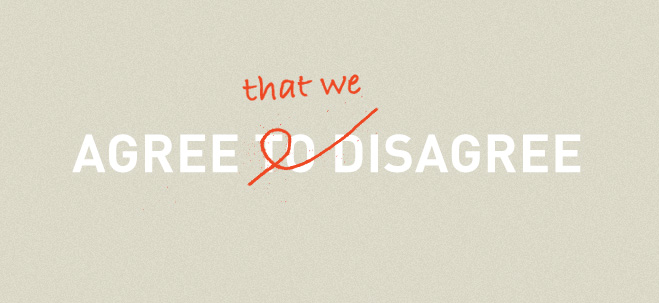
Agreeing that We Disagree: How Leaders Can Utilize Conflict
Conflict is opportunity—but rarely do we see it that way.
There’s a commercial out where a group of people are standing around the water cooler talking when a giant elephant suddenly inflates itself right in the middle of their conversation. They can’t move—let alone breathe—without dealing with it. We watch them stand there—uncertain and stuck—not talking about the elephant as if their life depended on it.
I’ve seen people in organizations respond to the possibility of conflict—especially in situations when the stakes are high—in much the same way. There’s that uncomfortable, palpable silence that happens in meetings when everyone tries to avoid the elephant in the room. Or the meeting after the meeting, where people speak their truths candidly in a shared release of all that pent-up, unexpressed frustration.
“Behind every communication problem is a sweaty, ten-minute conversation you don’t want to have.”
— Gay Hendricks
I’ve observed people trying to get around this by somewhat triumphantly “agreeing to disagree”. This usually marks an end to the conversation and the subject of the disagreement. The conflict goes unaddressed. The underlying disagreement we leave on the table silently remains, eventually resulting in an organizational or operational breakdown surfacing when we least expect—or want—it.
The ten-minute conversation we’re not having results in lost potential for our organization—and for us. When we avoid having these difficult conversations, we also inadvertently block new possibilities and opportunities from appearing. Conversely, when we do have these “sweaty” conversations, critical work gets done. This is where we learn and grow and innovate together.
Now is the time to start seeking out, surfacing, and utilizing conflict. Let’s agree that there’s an elephant in the room and name it! Let’s have the disagreement and the conversations that follow! Are you afraid of the consequences? Of course you are. But consider this:
You were hired for your point of view. Your ideas and opinions represent your work.
You’ve been given role responsibility in your organization. If you take that responsibility seriously, you’ll no doubt have an idea or hold an opinion that opposes a colleague (perhaps even a boss) who has a different role responsibility. With this kind of set-up, conflict is not a matter of “if”. It’s a question of “When?”
Your job as a leader requires effective conversations in the presence of conflict for the sake of what is possible for you, for your colleagues, and the overall success of your shared commitments.
Instead of emphatically agreeing TO disagree, we can take another approach. We can declare the presence of the elephant when it shows up—by “agreeing WHEN we disagree”. We can name the elephant—by “agreeing THAT we disagree about X”. With these two agreements on the table, we can begin to look at our different ideas and opinions together.
This may require we have in place a fundamental agreement about what we’ll do when we see the elephant. An agreement and a commitment to each other that we establish in our role relationships to declare when we’re in disagreement and to stay in conversation with each other after we agree that we disagree.
Embracing and using conflict in this way offers us the opportunity to turn our disagreements into learning (from each other), growth (our own), and innovation (for our organization).